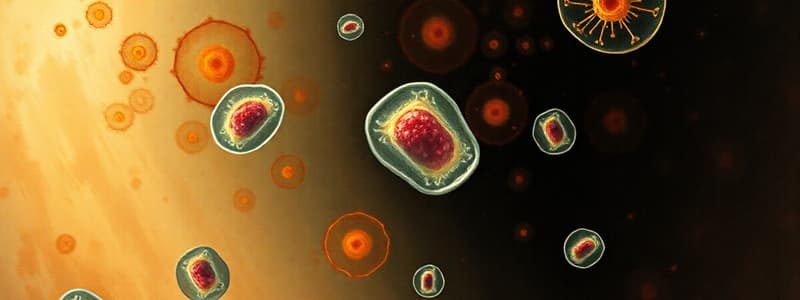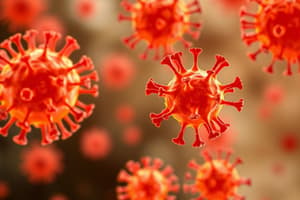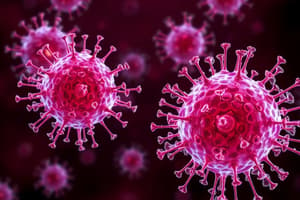Podcast
Questions and Answers
What is the primary role of B cells in adaptive immunity?
What is the primary role of B cells in adaptive immunity?
B cells provide antibody-mediated immunity against antigens and pathogens in body fluids.
Explain the significance of memory cells in the adaptive immune response.
Explain the significance of memory cells in the adaptive immune response.
Memory cells allow the immune system to respond more effectively and quickly upon subsequent exposures to the same antigen.
How does the property of tolerance benefit the immune system?
How does the property of tolerance benefit the immune system?
Tolerance helps the immune system ignore normal self-antigens, preventing autoimmune reactions.
What distinguishes T cell-mediated immunity from B cell-mediated immunity?
What distinguishes T cell-mediated immunity from B cell-mediated immunity?
Describe the process of antigen recognition in T and B cells.
Describe the process of antigen recognition in T and B cells.
What are the two main classes of activated T cells, and their respective functions?
What are the two main classes of activated T cells, and their respective functions?
Illustrate the role of versatility in the adaptive immune system.
Illustrate the role of versatility in the adaptive immune system.
What is the significance of lymphoid stem cells in the development of T and B cells?
What is the significance of lymphoid stem cells in the development of T and B cells?
What is the role of antibodies in neutralization during the immune response?
What is the role of antibodies in neutralization during the immune response?
How do primary and secondary immune responses differ after antigen exposure?
How do primary and secondary immune responses differ after antigen exposure?
Describe the process of lymphocyte activation upon exposure to antigens.
Describe the process of lymphocyte activation upon exposure to antigens.
What are the two classes of MHC proteins, and where are they located?
What are the two classes of MHC proteins, and where are they located?
Explain the functions of the four types of T lymphocytes.
Explain the functions of the four types of T lymphocytes.
What is the function of the variable segment in an antibody?
What is the function of the variable segment in an antibody?
Describe the structural components of an antibody.
Describe the structural components of an antibody.
What are the five classes of antibodies?
What are the five classes of antibodies?
How does IgM function in the immune response?
How does IgM function in the immune response?
What role does IgG play in immune protection?
What role does IgG play in immune protection?
Explain the process of agglutination in the context of antibody action.
Explain the process of agglutination in the context of antibody action.
What is the significance of the constant segment in antibodies?
What is the significance of the constant segment in antibodies?
What happens to cytotoxic T cells once they are activated?
What happens to cytotoxic T cells once they are activated?
How do antibodies neutralize pathogens?
How do antibodies neutralize pathogens?
What is opsonization and why is it important?
What is opsonization and why is it important?
What is the role of memory T cells in the immune response?
What is the role of memory T cells in the immune response?
What triggers the release of histamine during allergic responses mediated by IgE?
What triggers the release of histamine during allergic responses mediated by IgE?
How do helper T cells contribute to the immune response?
How do helper T cells contribute to the immune response?
What is the function of suppressor T cells after an immune response?
What is the function of suppressor T cells after an immune response?
What triggers the activation of lymphocytes?
What triggers the activation of lymphocytes?
Define what MHC proteins are and their importance in the immune response.
Define what MHC proteins are and their importance in the immune response.
What differentiates Class I MHC proteins from Class II MHC proteins?
What differentiates Class I MHC proteins from Class II MHC proteins?
How does a phagocyte become an antigen-presenting cell?
How does a phagocyte become an antigen-presenting cell?
What is the significance of haptens in immune responses?
What is the significance of haptens in immune responses?
What is antigen presentation?
What is antigen presentation?
What are phagocytic cells, and can you name three examples?
What are phagocytic cells, and can you name three examples?
In which circumstances do Class II MHC proteins appear on a cell membrane?
In which circumstances do Class II MHC proteins appear on a cell membrane?
Explain the role of Class I MHC proteins in antigen presentation.
Explain the role of Class I MHC proteins in antigen presentation.
What triggers the expression of abnormal peptides in relation to Class I MHC proteins?
What triggers the expression of abnormal peptides in relation to Class I MHC proteins?
How are abnormal peptides incorporated into Class I MHC proteins?
How are abnormal peptides incorporated into Class I MHC proteins?
Describe the process that leads to Class I MHC proteins reaching the plasma membrane.
Describe the process that leads to Class I MHC proteins reaching the plasma membrane.
How do phagocytic APCs use Class II MHC proteins in immune response?
How do phagocytic APCs use Class II MHC proteins in immune response?
What is the significance of displaying antigenic fragments on Class II MHC proteins?
What is the significance of displaying antigenic fragments on Class II MHC proteins?
What cellular mechanisms allow for the binding of antigenic fragments to Class II MHC proteins?
What cellular mechanisms allow for the binding of antigenic fragments to Class II MHC proteins?
What distinguishes Class I MHC proteins from Class II MHC proteins in terms of their function?
What distinguishes Class I MHC proteins from Class II MHC proteins in terms of their function?
Flashcards are hidden until you start studying
Study Notes
Introduction to Adaptive Immunity
- Adaptive immunity is the third line of defense, activated when innate defenses are insufficient.
- This system responds specifically to antigens, utilizing T cells and B cells to combat infections.
- It develops immunological memory, enhancing responses to subsequent infections.
- Key properties of adaptive immunity include:
- Specificity
- Versatility
- Memory
- Tolerance
Types of Immune Responses
- T cells mediate cellular immunity against infected or abnormal cells.
- B cells mediate humoral immunity focusing on pathogens in body fluids.
Properties of Immunity
- Specificity: Individual T or B cells react only to unique antigens through antigen recognition.
- Versatility: Diverse lymphocyte types are produced to target various antigens; activated lymphocytes clone themselves.
- Memory: Inactive memory cells persist after initial exposure, enabling quicker responses upon reinfection.
- Tolerance: The immune system typically disregards normal self-antigens.
Development of T and B Cells
- Lymphoid stem cells originate in the bone marrow; some mature into B cells, others migrate to the thymus to become T cells.
- Activated T cells differentiate into:
- Cytotoxic T cells (TC) - attack infected or abnormal cells.
- Regulatory T cells - include helper T (TH), memory T (TM), and suppressor T (TS) cells.
Function of T Cells
- Cytotoxic T Cells: Directly target and destroy infected or foreign cells.
- Memory T Cells: Remain in circulation and can rapidly activate during re-exposure to antigens.
- Helper T Cells: Activate to stimulate B cells and further immune responses upon encountering antigens presented by phagocytes.
- Suppressor T Cells: Modulate or inhibit immune responses after effective pathogen clearance.
Activation of Lymphocytes
- Lymphocyte activation occurs upon exposure to antigens, predominantly protein-based substances.
- Haptens are partial antigens that induce immune responses when bound to body proteins.
- Major histocompatibility complex (MHC) proteins on cell surfaces help identify self from non-self.
- Two classes of MHC proteins:
- MHC I: Present on all nucleated cells; signals abnormal cells to be destroyed.
- MHC II: Found on specialized antigen-presenting cells (APCs); signals presence of pathogens.
Antigen Presentation
- Class I MHC proteins display abnormal peptides on infected cells to alert the immune system.
- Class II MHC proteins present processed antigens on APCs, indicating the presence of harmful pathogens.
Antibody-Mediated Immunity: Antibodies
- Five classes of antibodies (immunoglobulins): IgG, IgA, IgM, IgE, IgD, each with distinct functions.
- IgM: First antibody produced; effective in agglutinating pathogens.
- IgG: Most abundant; crosses the placenta and provides passive immunity to the fetus.
- IgA: Found in secretions like tears and saliva; protects mucosal surfaces.
- IgE: Involved in allergic responses; binds to mast cells and basophils.
- IgD: Present on B cells, facilitates antigen binding.
Actions of Antibodies
- Neutralize pathogens by blocking binding sites.
- Induce precipitation and agglutination, enhancing pathogen clumping.
- Activate the complement system leading to lysis of pathogens.
- Enhance phagocyte activity and attract them to infection sites.
- Increase inflammation and prevent microbial adhesion.
Primary vs. Secondary Immune Responses
- Primary Response: Slower, takes about two weeks to peak after initial exposure; antibodies gradually rise.
- Secondary Response: Faster and stronger due to memory cells, capable of quick activation even at lower antigen levels; may last for decades.
Revision Questions
- Key terms to define: adaptive immunity, cell-mediated immunity, antibody-mediated immunity, antigen, antibody, hapten, MHC protein.
- Explain the origins of T and B lymphocytes.
- Compare the two forms of specific immunity.
- Describe the functions and types of T lymphocytes.
- Detail the lymphocyte activation process upon antigen exposure.
- Identify the locations of MHC class I and II proteins.
- Describe the immune response assistance provided by class I and II MHC proteins.
Studying That Suits You
Use AI to generate personalized quizzes and flashcards to suit your learning preferences.





